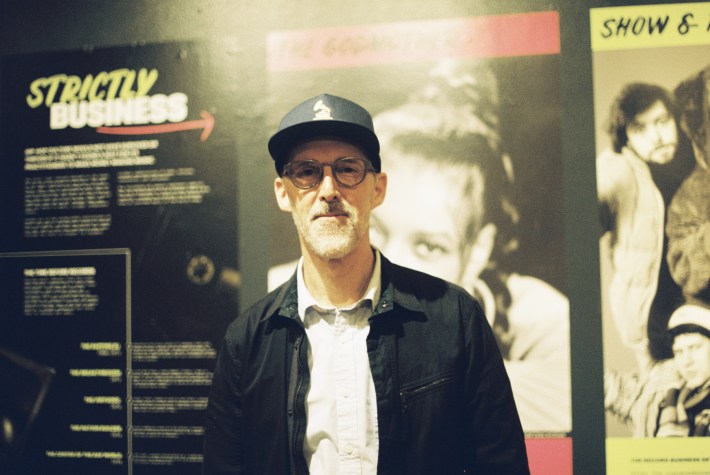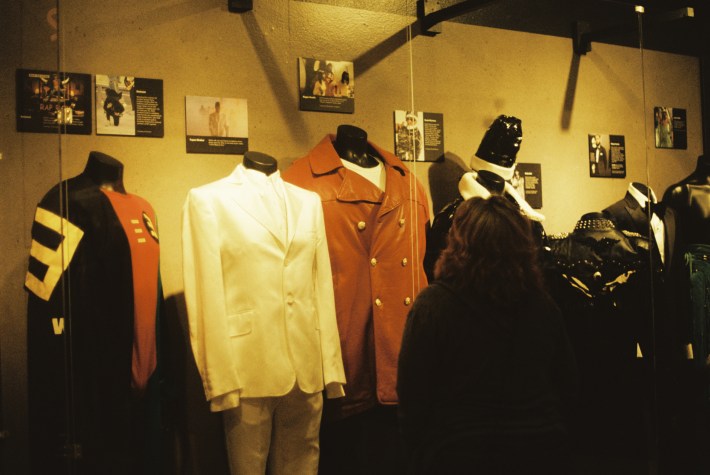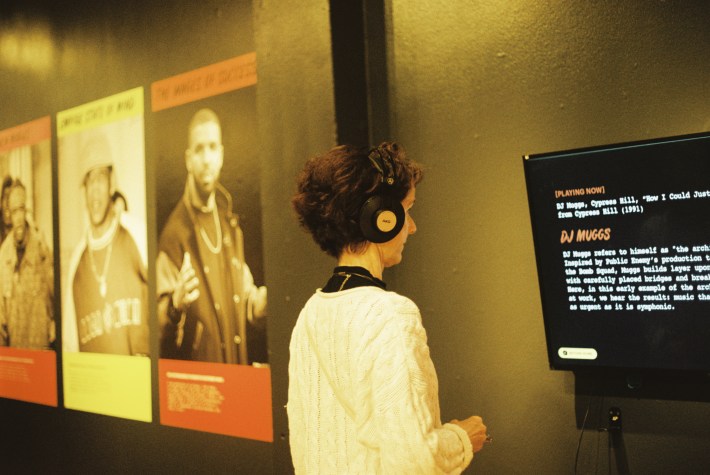Hip-Hop America: The Mixtape Exhibit
Woody Guthrie Center
March 28, 2025
Digable Planets
Cain’s Ballroom
March 30, 2025
Life imitates hip-hop. The music that was birthed out of creative expression in the 1970s has become the art of the modern day and transformed the way we live, from fashion to technology to marketing. That influence is exactly what the Woody Guthrie Center showcases with the GRAMMY Museum’s traveling exhibit, “Hip-Hop America: The Mixtape Exhibit,” whose opening celebration—culminating in a show by Digable Planets, one of the most hip-hop groups ever to touch a mic—made for one of the most hip-hop weekends ever in Tulsa.
“Hip-Hop America” is a powerful exhibit that points to how massive and wide-ranging hip-hop really is. In the words of the Woody Guthrie Center’s director, Cady Shaw, the exhibit is “not just hip-hop—it’s the business, it’s the fashion, it’s the start, it's the origins, it’s all these different stories. It’s not just hip-hop as a monolith. It’s hip-hop from the West Coast, from the East Coast, from Chicago, from Memphis, from Texas, it’s all of these different styles that come to create hip-hop. And I think that’s what most people will be surprised about.”

In the iconic words of the late 2Pac, “we all came from a woman.” Hip-hop did too: it was a woman who started this movement that would take the world by storm. One summer in 1973, high schooler Cindy Campbell needed school clothes, so she came up with a plan for a back-to-school party-slash-clothing drive: rent out a rec room in her Bronx, New York, apartment complex and bring in her brother, the legendary Kool Herc, to DJ. That date—August 11, 1973—would become the birthdate of hip-hop.
One of the strongest elements of "Hip-Hop America" is how it highlights the ways that women have been part of the heart and soul of the genre. From the beginning, women have helped push the art form as graffiti artists, as break dancers or “b-girls,” and in many other pivotal roles. Hip-hop wouldn’t have gone mainstream if record executive Sylvia Robinson hadn’t taken a chance on the group The Sugarhill Gang, a chance that paid off with their 1979 hit single "Rapper's Delight." (Everyone still enjoys this record, except for probably Grandmaster Caz, whose lyrics were stolen word for word by TSG. They didn’t even take out the part where Caz spells out his name.) And let's not forget about women’s influence on hip-hop fashion, such as the big hoop earrings or the Kangol hats, as well as the hairstyles that are still worn to this day.

Fashion items like those are only a few of the objects on display in this exhibit, which also lifts up the urgency of something we don’t think about often enough in the digital age: archiving. The rapper Egyptian Lover probably didn’t buy his custom Roland TR-808 Rhythm Composer with the intention of displaying it in a museum, nor did Andre 3000 wear his outfit for the “Hey Ya” video thinking it would one day travel around the country in a glass box. But I’m glad I got to see both of these crucial pieces of hip-hop history.
Among the coolest things on display are the various handwritten lyrics, poems, and letters from some of hip-hop’s greatest. In this new media world, we’re always presented with the finished product, no mistakes, no setbacks, and especially no scribbles. I counter this idea with a lyric from J. Cole: “It’s beauty in the struggle.” Some of that beauty is being erased with digital media, and this exhibit is an example of why keeping things such as song lyrics or outfits, or even that big clock that you might wear around your neck, is important to history and storytelling.


photos by GOLDIELXCS FILM
At the “Hip-Hop America” opening, I asked Jasen Emmons (the GRAMMY Museum's chief curator, who worked on this show with four co-curators and a 20-member advisory board) what he most wanted to bring to the forefront in this exhibit. “We thought a lot about ‘How do we show how multi-faceted hip-hop is?’” he said. “Because I think often people think, ‘No, I don’t like hip-hop.’ I think, ‘Well, the way you're dressing is hip-hop.’ There’s so many ways that it’s permeated our culture that a lot of the time people don’t even stop and think about that: the way that music videos are done, or the way that [it has influenced] clothes or food [or] hairstyles. All these things came out of hip-hop. It’s so part of the broader culture now that I think sometimes both the respect and its roots get overlooked. So I think for us, showing how multi-dimensional it was was really important.”

Emmons emphasized the importance of centering hip-hop’s five elements (emceeing, DJing, graffiti, breakdancing, and historical knowledge) in the exhibit, and it does that for sure. But he also said he wanted “to make sure we’re talking about the massive multi-global business” of hip-hop. From the clubs, to the promoters, to the radios, to the stores, and of course the people who love the music, local music scenes helped take hip-hop from the Bronx to around the country and the world. “Hip-Hop America” highlights fourteen different cities that were pivotal to hip-hop’s success, and Tulsa is starting to find its place on that map. As well as investing in its own artists, Tulsa has been bringing in major hip-hop acts for years now. Although we still have a long way to go, hip-hop legends are finding out firsthand that Tulsa has something special.

“We be to rap what key be to lock”: to know this line is to know hip-hop and the legendary Digable Planets, who played a one-night-only show at Cain’s to celebrate the “Hip-Hop America” opening. From the minute they joined up in the late 1980s, Digable Planets' three members—Butterfly, the musical genius of the group; Ladybug Mecca, the voice; and Doodlebug, the lyrical monster—created a sound that changed the way we listen to music. Their songs were politically charged, with lyrics that represented the time and most importantly, the people. They incorporated live instruments into recordings and, with each album, showed just how deep their jazz roots were. These same songs still live on through sampling and the support of their amazing fans.
A multi-generational crowd showed up for the Digable Planets magic on Sunday night. They engaged with every song, and they supported by buying merch and bringing treasured memorabilia to be signed. Hip-hop heads reminisced on the first time they heard certain records and which ones they hoped would be played that night. Concertgoers from out of town talked about seeing their favorite hip-hop acts and traveling to Tulsa for the sole reason of being at this show.
And Digable Planets didn’t disappoint. With no opener and a backing band, their set went well over an hour, but it never felt like it. It felt like the first time I heard “It’s Good To Be Here,” “9th Wonder,” or “Borough Check.” And of course, as the night went on, they teased the crowd with the unspoken question: will they play “Cool Like Dat”?




Digable Planets at Cain's | photos by GOLDIELXCS FILM
It’s one thing to hear Ladybug Mecca rap in your speakers; it’s a whole other experience to see her rock the stage. She has a commanding stage presence and a voice that cuts through the beat. Butterfly showed his wings on the keyboard and also played some backing samples as he rapped. Doodlebug is the wildcard, with enough showmanship and lyrics to take on any emcee. He definitely still has it. And yes, of course, they played “Cool Like Dat.”
Where would the world be without hip-hop? Luckily, we’ll never know. It’s a genre that has transformed every facet of life and continues to be the voice of the people. The voice of Tulsa is also getting louder as more hip-hop acts play here; they see the crowds, and most importantly, they see the music scene that Tulsa has built. I have no doubt that one day Tulsa will earn a spot on the map of cities that contributed to hip-hop’s success, especially when groups like Digable Planets come and experience just how amazing this place is. Until then, go see “Hip-Hop America: The Mixtape Exhibit” at the Woody Guthrie Center, on display now until September 7—and consider how your own life might be more hip-hop than you realize.






